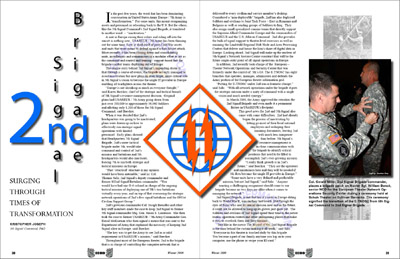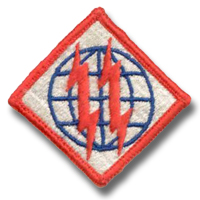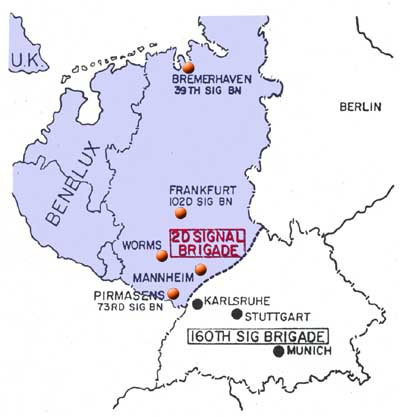If you do
NOT see the Table of Contents frame to the left of this page, then
Click here to open 'USArmyGermany'
frameset |
2nd
Signal Brigade
5th Signal Command
Looking for more information from military/civilian
personnel assigned to or associated with the U.S. Army
in Germany from 1945 to 1989. If you have any
stories or thoughts on the subject, please contact me . .
|
|
|
|
|
| |
| Brigade
Introduction |
|
| 1982
|
| (Source: Welcome
to the 2d Signal Brigade. 2nd Sig Bde Pamphlet 608-7, 22 July
1982.) |
|
 2nd Signal Group DUI
2nd Signal Group DUI
1. HISTORY OF 2D SIGNAL BRIGADE. The 2d Signal Brigade
was originally constituted in France as the 3348th Signal Service
Group. It saw service in Furope from 1944 to 1946. The Group was
reactivated in May of 1946 at Fort Monmouth, and was redesignated
the 2d Signal Service Group shortly thereafter. In 1955, the Group
was deactivated at Camp Gordon, Georgia. In 1961 the Group was activated
for the third time at Fort Bragg, North Carolina, where it served
until being alerted for movement to the Republic of Vietnam in the
spring of 1965. From 1965 until 1971, the Group provided Army area
signal support for US combat forces in Vietnam, participated in
fourteen campaigns and was twice awarded the Meritorious Unit Commendation.
On 23 October 1971, the 2d Signal Group was deactivated at Fort
Lewis, Washington. It was again activated in Europe on 1 June 1974
to assume responsibility for communications in the northern half
of Germany, Holland, Belgium, and England. 2d Signal Group was redesignated
as 2d Signal Brigade on 1 October 1979.
|
|
|
|
2.
MISSION OF 2D SIGNAL BRIGADE. 2d Signal Brigade has the
following mission:
|
|
a. |
To operate
and maintain as a part of the Defense Communications System:
|
|
(1) |
1 AUTODIN
Switching Center |
|
(2) |
1 AUTOVON
Switching Center |
|
(3) |
Satellite
Communications Terminals |
|
(4) |
23 Wideband
Stations |
|
(5) |
4 Major
Technical Control Facilities |
|
(6) |
1 National
Command Authority Station |
|
(7) |
1 Long
Haul High Frequency DCS Radio Facility |
|
|
|
|
b. |
To maintain
past, camp and station communications within Northern Europe,
including the following: |
|
(1) |
32 Telecommunications
centers |
|
(2) |
69 Dial
Telephone Exchanges |
|
(3) |
15 Narrow
Band Subscriber Terminals |
|
(4) |
2 Second
Switches |
|
(5) |
18 Dial
Service Assistance Switchboards |
|
|
|
|
c. |
To operate
and maintain a Special Command and Control Communications
System for the US European Command (EUCOM)(ECCCS/Cemetery): |
|
(1) |
29 ECCCS
and Cemetery Net stations |
|
(2) |
1 Cemetery
Net Station |
|
(3) |
3 NODAL
Point Stations and 3 remote switches |
|
(4) |
52 Mobile
Stations |
|
(5) |
1 Communication
Relay Control Station |
|
|
|
|
|
|
|
|
|
3.
2D SIGNAL BRIGADE ORGANIZATION. To accomplish its mission,
the 5th Signal Command, our higher headquarters located in Worms,
Germany; has divided the European area north of the Alps into two
areas of operation. North of the boundary line is the 2d Signal
Brigade; south of the line is the 160th Signal Brigade. Support
for both these brigades is provided by the 21st Support Crnmnand.
Our organization is as follows:
|
|
|
|
2D
SIGNAL BRIGADE
MANNHEIM, FRG
|
|
| |
|
|
39th
Signal Battalion
Bremerhaven, FRG |
73d
Signal Battalion
Pirmasens, FRG |
102d
Signal Battalion
Frankfurt, FRG |
|
|
|
128th
Signal Company
Schinnen, Holland |
267th Signal Company
Pirmasens, FRG |
228th
Signal Company
Frankfurt, FRG |
|
|
|
518th
Signal Company
Linderhofe, FRG |
270th Signal Company
Pirmasens, FRG |
232d
Signal Company
Worms, FRG |
|
|
|
532d Signal Company
Giessen, FRG |
298th Signal Company
Kaiserslautern, FRG |
261st
Signal Company
Hanau, FRG |
|
|
|
581st Signal Company
Bremerhaven, FRG |
327th Signal Company
Zweibrücken, FRG |
|
|
|
|
|
|
The 39th Signal Battalion commands all units north of Giessen, including
those units in Belgium, the Netherlands, and the United Kingdom
plus Satellite Station AN/FSC-78 at Harrogate, England. In the 2d
Signal Brigade's southern sector, the 102d Signal Battalion commands
all units east of Worms and the 73rd Signal Battalion commands all
units west of Worms plus Satellite Stations AN/MSC-46 and AN/FSC-78
at Landstuhl.
|
|
|
4.
OPERATIONS. The backbone of the Defense Communications
System (DCS) in Europe is called the European Wideband Communications
System (EWCS). The 2d Signal Brigade has the responsibility for
the central and northern Germany and Benelux portions of the system;
both American and German equipment is used. Within this system
we operate wideband stations, technical control facilities and
minor patch and test facilities that control approximatelv 335
trunks and 2500 circuits of standard and special service communications.
Our stations are permanently installed fixed plants.
To coordinate, control and supervise the transmission media and
equipment of the EWCS, the 2d Signal Brigade has four major technical
control facilities located at Pirmasens, Donnersberg. Frankfurt,
and Worms.
In support of our DCS mission, we operate 1 of the 16 overseas
automatic message switching centers in the DCS Automatic Digital
Network (AUTODIN) located at Pirmasens, FRG. This network is similar
to networks designed to deliver record communications or telegrams.
However, AUTODIN, the Department of Defense record communications
network, has been designed to meet special security, speed and
reliability requirements. Security is provided by encoding all
messages which leave an automatic message switching center. Speed
is attained by computer processing each message in accordance
with its precedence. Reliability is achieved by locating switching
centers strategically throughout the world, by providing necessary
back-up equipment, and by connecting the switching centers with
many diversely routed, highspeed circuits. Our switch at Pirmasens
can handle an input of up to 200 separate subscribers, and processes
an average of 65 to 70,000 messages per day.
In the system with the automatic message switching center, we
operate 32 telecommunications centers throughout our area of operation.
These telecommunications centers provide record communications
service for all units and activities in their immediate vicinity.
The 2d Signal Brigade operates three satellite terminals: an AN/FSC-78
at Harrogate, England; an AN/MSC-46 (which is scheduled to be
replaced by the GSC-39 in the near future); and an AN/FSC-78 at
Landstuhl. All terminals provide the most advanced technological
and reliable access for selected subscribers into the worldwide
Defense Communications System.
At Pirmasens, we have a long haul, high frequency radio facility
operated by the 73d Signal Battalion. This facility has a dual
role: on one hand it operates a radio trunk to Incirlik, Turkey;
on the other hand it serves as the only Army entry point into
the European Defense Communications System for high frequency,
contingency operations. An average of 15 high frequency, contingency
missions are activated through this station annually.
An Automatic Voice Network (AUTOVON) switching center is operated
at Donnersberg. This switch is a part of the AUTOVON system, the
principal long haul telephone network of the DCS. The purpose
of the AUTOVON network is to provide a worldwide, automatic voice
communications system to fulfill the nonsecure voice requirements
of the Department of Defense. The AUTOVON System began in 1964
with 9 switches; it now has 16 operational switching centers overseas.
Our Donnersberg switch has 377 connected subscribers.
Both narrow
band subscriber terminals and secure voice cordless switchboards
are parts of the Defense Communications System Automatic Secure
Voice Communications (AUTOSEVOCOM) network. This network has approximately
1400 subscribers throughout the world. It is made up of manual
and automatic switches and can provide from 3 to 250 subscribers
with secure voice service.
In support of the AUTOSEVOCOM network, the 2d Signal Brigade operates
15 narrow band subscriber terminals and two secure voice cordless
switchboards. The former is basically an AUTOVON circuit with
secure voice service, and the latter is a manual switchboard that
can provide such service for up to 15 local subscribers.
The 2d Signal Brigade provides command and control communications
support to the US European Command (USEUCOM) and the 59th Ordnance
Brigade at 33 locations. This support is provided through systems
commonly referred to as the Europe Command Control Console System (ECCCS) and the Cemetery Net. Both systems are utilized to pass
emergency action messages from HQ USEUCOM to the various 59th
Ordnance Brigade detachments in our area of operations. The Cemetery
Net is an HF network utilizing the AN/FRC-93 and KWT-6 Radio sets
at fixed locations. To supplement the fixed locations and support
the Ordnance and Artillery detachments when they are deployed
to the field, the 2d Signal Brigade operates and maintains 52
mobile contingency units, utilizing the AN/MRC-117 (37), AN/TRC-133A (4), and AN/GRC-122A (11) radio sets.
(1) Cemetery Net radio equipment
AN/FRC-93 -- a high frequency (HF) commercial single-sideband radio set adapted for military use (AN/FRC-93).
KWT-6 -- KWT-6
AN/MRC-117 -- AN/MRC-117
AN/TRC-133A -- this radio set, composed of five single-sideband (SSB) radios, was the prime means of Pershing communications (WIKIPEDIA entry).
AN/GRC-122A -- a shelter-housed transportable radio teletypewriter set that uses
the AN/GRC-106 as its major basic component. The AN/GRC-122 is authorized for air defense
artillery battalions primarily to provide teletypewriter communication with higher
headquarters.
|
|
|
(Source: ECHO, Winter 2009 edition -  ) ) |
|

2nd Signal Brigade and Transformation.
|
|
|
|
|
If you have more
information on the history or organization of the 2nd Sig Bde, please
contact me . . |
 |
|
| |
| 2ND SIGNAL
BRIGADE UNITS - 1970s-80s |
 2nd
Sig Bde
2nd
Sig Bde |
 39th
Sig Bn
39th
Sig Bn |
 73rd
Sig Bn
73rd
Sig Bn |
 102nd
Sig Bn
102nd
Sig Bn |
|
|
 |
|
| |
| Related Links: |
|
| |
| |
| |
|

 2nd Signal Group DUI
2nd Signal Group DUI





